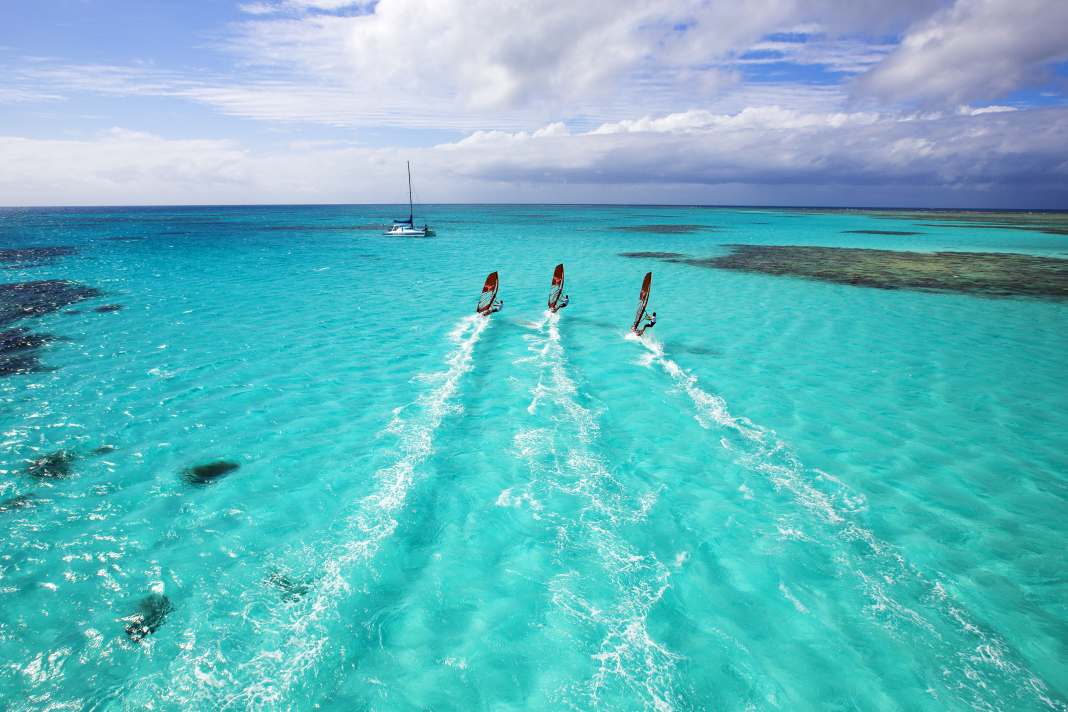





- The injury: involuntary break after 26 years
- Strategy and flexibility for events
- The equipment: 80 kilos of photographic equipment
- Recommendations for beginners: The right equipment
- Challenges: Heat flicker and picture quality
- Exposure and image processing: individual approach
- Tips and priorities for a good action photo
- Photographing in poor light and weather
- Cameras lost in the water
- Action cams as an alternative
- Tips for speed blur photos
- The perfect time of day
The injury: involuntary break after 26 years
John, how are you doing with your injury?
It's not the best, to be honest. I tore my Achilles tendon in Fuerteventura. I'm pretty much immobile for a while.
How did that happen?
It just happened. There's no real reason for it. I'm not sure if I didn't drink enough water and was dehydrated, or this, that and the other. Sometimes it just happens. I wasn't playing squash or anything like that. It's just annoying.
How long will the recovery take?
It's not just a few weeks, but months. I had hoped to be able to go to Sylt, but I'm not sure yet. That would be 10 weeks after the incident.
It must be frustrating to miss the events.
It's quite annoying because I've been doing this for 26 years. I haven't missed many events. It felt strange not to be there. It's the first time I've watched an event on livestream. I think I've only missed one because of my wedding and another because I had a photo shoot in Mauritius with Duotone, and then they announced this event at short notice. I think it was on Lake Garda.
But your cameras are ready?
Yes, the cameras are charged and waiting in the boxes to be used. It's strange when you fall out of photography mode. You have to get back into it somehow.
Strategy and flexibility for events
Are you still nervous before an event?
I wouldn't call it nervous. You just know that an event like Tenerife or Sylt is a pretty big mountain of work. When you go there, you start at the bottom of the mountain and you just have to work your way through all the photos. They're not all going to come in one day. You're not going to get all the pictures from all the different people. A lot of people, all the riders want their pictures right away, but they have to wait, if you know what I mean.
Do you think about new perspectives before an event?
I often look at the weather forecast. As in Pozo we knew that it would immediately reach 50 knots would give. So you know you have to go pretty hard early on because those are probably going to be the best days. But there's quite a lot of pressure when it's like that because everyone expects you to get the best shots, but that doesn't always happen. You're not a miracle worker.
How do you proceed during the event?
I like to move around a lot, and that can often mean missing out on things here and there. You have to plan your day. I don't like sitting in one place all day. And you also know that the media want to see the pictures of the winner but also the action.
Are there any particular challenges as a result?
For example, if Daida wins the women's wave classification, you know there will be some epic shots right in her corner of the beach where she comes in. And at the same time there might be some super action on the water. Sometimes you have to sacrifice one thing for another. And you have to carry around the right cameras and lenses to capture those moments on the beach, as well as the big lens for the action. In places like Pozo, it's not easy - with the rocks and the wind - to lug all that stuff around.
Do you have specific concepts for your work?
For a lot of events, I might set myself a challenge - to create a theme for myself. Maybe at one event I make everything look happy, or at another event I make everything look more dramatic or something like that. These are just things to keep me entertained sometimes.
I create themes for myself: At an event I make everything look happy, at an event I make everything look dramatic. (John Carter)
Photographing events is different from arranged shoots?
Yes, but photographing events is completely different to an arranged shoot where you can agree everything with the drivers. There is probably less stress at such shoots. At an event, you always have to report on what's happening. And you need a picture story of the day. From the skippers meeting to the winners celebrating - or the losers. You know - capturing those emotional moments. So once the action, different crew shots, crowds, flags, that's the kind of event story. And every day writes a new story.
The equipment: 80 kilos of photographic equipment
How much equipment do you take with you to the events?
When I came back from Fuerteventura with my ruptured Achilles tendon, I had to bring back 80 kilos of luggage. I have one of those big, black hard boxes. In it is my water housing with a few connections, all my chargers, a few lenses. There are lots of small items, like flashes. I take two flashes with me. At the last two events I've only used two Canon R5 housings, which are mirrorless housings. They are quite light, but of very good quality.
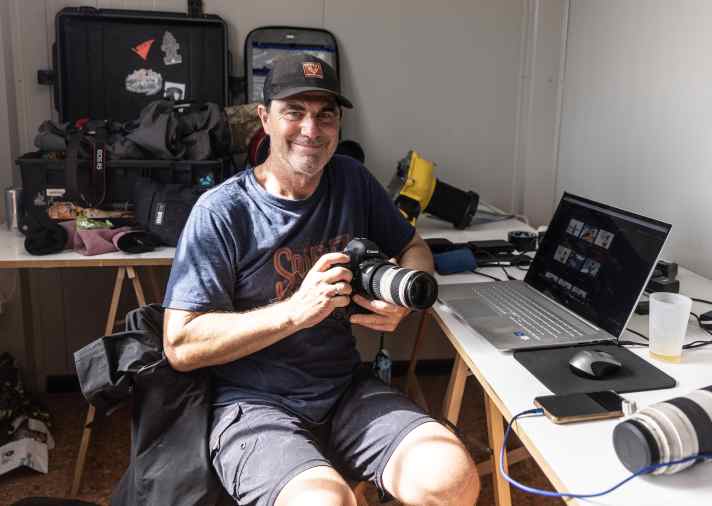
Which lenses are you using?
My big lens is a Canon 500/F4. And I have a big Gitzo tripod for it - which was quite expensive. Then I have a Canon 100-500, which is kind of an all-round lens on the boat and on the beach. I take a 24-70 with me for general shots. A wide-angle 17-35. I take a 70-200/F4 that goes in my water housing. And I take an 85/1.2, which is my favourite lens for portraits. I also take a 24-105, which also goes in the water housing. There are many lenses.
Do you also use drones?
I also have two drones that I carry around. A Mini 3 Pro. And then I also have a Mavic Air Pro. But you sometimes need a licence for that. So I use the small one where there's limited use for drones.
Recommendations for beginners: The right equipment
What would you recommend to someone who wants to start windsurfing photography?
There are many brands. Sony makes amazing equipment. Nikon is good. Canon is good. But I would say a really useful lens is the 100-400 or 100-500 lens for all your action. It can also be used for beach shots. It's a good lens to have around your neck. And you can be quite mobile with it. It's handheld. And then you might need a 24-70 or 17-35 wide angle for your other shots. And those two lenses can cover pretty much everything.
How does such a zoom compare to the Canon 500 with a fixed focal length?
I think the 500/f4 costs around 10,000 euros. So that's out of the range for most beginners. Whereas the 100-400 or the 100-500 also take amazing shots. And they are versatile. You'll find that some of the top level Olympic photographers only use fixed focal lengths. Because they want the best quality. But in windsurfing, versatility is a big factor, I would say.
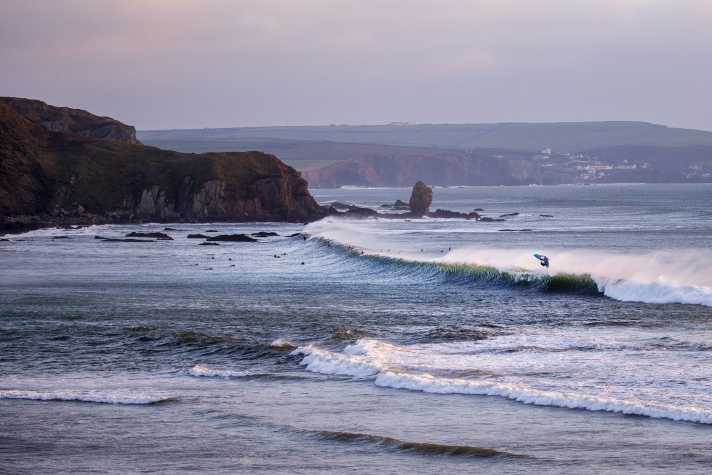
Can the 100-500 also be used from a boat?
Yes, I use it for racing shots and can zoom in and out. It's really useful. I would also recommend it to someone who wants to take pictures of their friends. If you follow Inna Bru, she's another photographer at a lot of events, she uses the 100-400. And she gets really good shots with it. So it's a very useful lens. And it's sharp. And a lot of people wouldn't notice the difference between this and a fixed 500. Maybe if you're working for a magazine and you're really looking at your shots very closely, you might see the difference, but on social media, nobody will notice the difference.
Challenges: Heat flicker and picture quality
I once had problems with sharpness when shooting over hot sand. Have you ever had similar experiences?
I had it in Chile. I spent the whole day taking photos and thought I had taken the best shots ever. And when I got them back, they looked like oil paintings. They were all blurred somehow. It was because of the difference between the cold water and the hot sun. It creates heat shimmer. Then you have to wait until the evening.
I thought I'd taken the best shots ever, but they looked like oil paintings. (John Carter)
Exposure and image processing: individual approach
How do you handle the exposure? Automatic or manual?
I use the camera's automatic mode, but I also adjust it according to the situation. I might adjust it by two thirds of an aperture or one aperture if I'm shooting into the sun. I always check my images in the viewfinder. I also shoot everything in RAW. And on top of that, I edit every image. I don't do batch processing. So if you see a gallery of mine, I've literally edited every image individually.
Would you generally recommend RAW as a file format?
It's a bit more work, but I'd say you'll get better results and you'll have more control over your final image than with a JPEG. Although the JPEG quality is pretty amazing these days. But I prefer to have the RAW file. I don't spend a lot of time editing, but I do edit every shot. Whether it's just straightening the horizon and making a few small colour corrections. But that depends on individual preference. You could have a gallery in 10 minutes with JPEG. But I prefer to go through all my shots. That's my system. Maybe I'm old-fashioned.
I edit each shot individually. Maybe I'm old-fashioned. (John Carter)
Do you have experience with smaller sensors? Is there a big difference in normal use compared to a full-frame sensor?
Some cameras have a crop factor of 1.3 or 1.6. Even on the R5 you can set a crop factor in the settings. But it doesn't really change anything - as long as you know what you're dealing with, it won't change anything. With a full-frame camera, of course, you get the full effect of a wide-angle lens. Whereas with a crop sensor, for example, a 35mm lens will look more like a 50mm. You just have to adapt to the sensor of your camera. Some people think that with my R5 in crop mode the camera is zoomed in more, which is obviously the case. But actually you're just taking out that part of the full frame. So there's no real difference, and the lens doesn't zoom in any more.
So you simply use a smaller part of the image?
John Carter: Yes, you just use a smaller part of the image. I don't think there's too much difference. I occasionally set my camera to crop mode. There's a Canon R7 camera that has a crop sensor, but the pictures from that are good too.
Tips and priorities for a good action photo
If you want to take a really good action shot, what is more important: the idea, the composition of the image, the action itself or the equipment?
It's all together. Obviously a good lens is really important. I would rank that pretty high, but everyone sees a picture differently. Everyone has a different idea of what the best photo is. At Pozo, Köster could take the highest jump of the day, and six different photographers could take it from different angles, and all of those shots could be great. It's really hard to say which is the best photo of something. I like a photo that's obviously high quality, shows a lot of interesting things, shows the manoeuvre, shows the surroundings, shows the height from top to bottom on a jump and then also has a wow factor. Maybe someone is falling or there's something incredibly dynamic about the athlete, or an emotional photo where you've captured that exact moment. You can see on Instagram which photos get the most likes. It's usually high jumps or huge waves or something incredibly dynamic from the athlete or an emotional photo. If you just post an average photo, you'll only get a few likes, but if you've captured something amazing, you'll see the difference. The most important thing is to have a good camera and a good lens, and to be in the right place at the right time. It's difficult, like I said, in pozo someone could jump 100 feet next to you, and if you only have a 500 lens it won't work - you have to anticipate and quickly switch to your wider angle setup and anticipate what's going on around you.
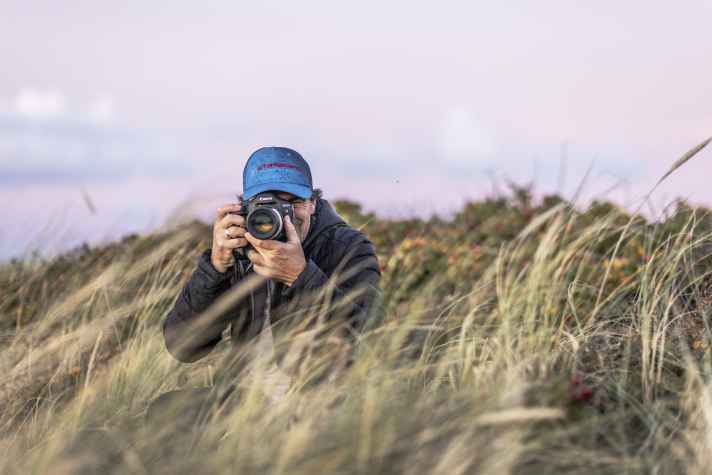
When we talk about amateurs photographing their friends on the beach or on the water - they often have the problem that the action is not so spectacular, but they still want attractive pictures. Do you have any tips on how to turn a normal jump that is perhaps only two metres high or a duckjibe into a beautiful picture?
Sometimes I lie down on the floor to get the foreground in the picture. I often think about the fact that of course it's easy when you're photographing professionals because they do amazing things. But sometimes we're at events with the youngest children, and that's more challenging because they're not doing such spectacular manoeuvres - it's similar to photographing amateurs. You have to try and make it interesting. Move around, change your angle, get down low, try different things. There's always a good photo to be taken, unless it's a really horrible day with lousy conditions. But if the conditions are reasonable, you should be able to get good shots of everyone. Sometimes your friends are the ones who take a ridiculous spill or do something that's interesting, especially in wild conditions. Sometimes the worse riders are better to photograph because they'll do something crazy.
Sometimes the worse drivers are better to photograph because they'll do something crazy. (John Carter)
Photographing in poor light and weather
The second problem for amateurs is that they don't always shoot in the best light on the Canary Islands or Maui. Do you have any tips on how to get good pictures even in bad weather, in Denmark or in Sylt conditions? Do you have any tips for camera settings or image editing?
If you have very little light in winter, you need to increase your ISO value. But once you start taking photos - everyone has a digital camera these days - it's always good to look at your photos on the back of the camera or in the viewfinder to see if your photo is dark. It's no good taking photos all day and only looking at them at the end of the day. I always do the same to make sure I've set everything correctly. With the R5, what you see through the viewfinder is pretty much what you'll see on your computer screen later. I find this very useful for analysing my photo and deciding whether it looks good or bad. When I'm shooting, I might overexpose an aperture to get it brighter, or just change my settings or ISO if I don't think enough light is coming in. Of course, if it's pouring with rain, your visibility is limited. You might not be able to shoot further than 50 metres. You can't see anything. These shots are kind of a waste of time and you're risking your camera equipment. Your batteries run down faster in the cold. There are many things you need to consider in bad weather.
Is there a cheap solution to protect your camera and lens in bad weather, or just these professional lens covers?
Just carry a bag around it. There's nothing worse than spending a whole day shooting in a place where it's damp and raining - it's bad for your camera. I've destroyed cameras a few times on Sylt just because I wouldn't normally shoot in those conditions, but because it was a competition you were forced into that situation. Even with a cover, they get damp and hot inside, and that's not the best situation for your camera. So try to cover them. Don't change your lens in the wind when sand is flying around because that will blow onto your sensor or you'll get dust on your sensor. One of the worst things I see with amateurs is that they haven't kept their sensor clean and you see all these smudges on the image. I don't know if you've seen that before, but it just looks terrible and needs a lot of post-processing. Most of the pros you see in Hawaii always have a cover on the big lens. It protects your lens in the long run, and there's usually always salt water in the air on the beach anyway, so it's better to cover them up.
Cameras lost in the water
Have you ever lost a camera in the water?
Yes, many. I've experienced everything. I've dropped cameras from boats. I jumped onto a jet ski in Sylt with two cameras around my neck, without any covers, and the jet ski tipped over. I destroyed everything. I had water covers that were leaking. I didn't close my cases properly before I went in the water, and I dunked it right in, and it filled up with water. Yeah, everything you can imagine has happened to me, but that's part of the game, I guess. The older and wiser you get, the more checks you do. When I go into the water now, the first thing I do is dip the camera in and out really quickly and check it. Then I dip it in a bit longer and then longer still. When I'm satisfied that everything is OK, then I go for a swim, but I don't normally go into deep water until I've done these checks, simply because I've made my mistakes. And before you go in the water, you also have to check all the settings on the camera. You don't want to suddenly realise you're shooting at ISO 12,000 or some nonsense like that and you can't change it without going back. So always double check everything.
Action cams as an alternative
Have you ever thought about using an action cam that is waterproof from the start, just for quick shots?
Since I have the housing, I tend not to, but I do use GoPros a bit, but more for mounting on a pole or something.
Which type of mounting do you like best? Do you like them more on the mast or on the tree or wherever?
On the pole. But in the past, before GoPros, many photographers were even more creative. We used to strap cameras with remote controls to the nose of a board and things like that. I used to strap the camera to the bottom of the mast, pointing upwards, and that was cool. I think I have pictures somewhere of Francisco Goya doing some big jumps.
But then you can't see the board, you can only see the rider and the sail, right?
Yes, but it's still cool. It's completely different to what you'd expect. But when they do a table top or something like that, you see the board, I think. I can't remember now, but you have to think about those shots in advance. But I like the camera on the mast. I used to have the highest percentage of covers from my mast camera shots when you used a real camera on it. Because it was so extraordinary. Nobody else was doing it. You remember Mike Eskimo? I photographed with him. He had a lot of pictures like that.
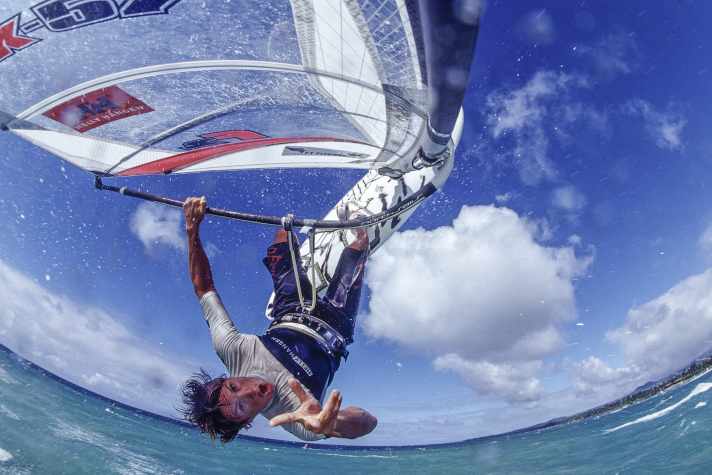
When you're shooting in the water, it's not just about protecting your equipment, it's also about protecting yourself, I think, protecting your head. You always use a helmet. Have you ever really needed it?
Yes, absolutely. I've been hit a few times. I've been hospitalised a few times. A young rider, he was in Maui on his first shoot, did a forward loop, basically straight at me. He went out of control and basically landed on my head, full force, out of control. I just curled up into a ball and I felt something hit my foot and it cut right through. When I surfaced, I held my foot out of the water and there was blood everywhere. I went to hospital and got 22 stitches in my foot. Another guy once did a wave 360 or something, and I was behind the wave. But somehow he flew out the back, separated from his board and landed feet first on my chest. It felt like I'd broken my ribcage. That was a pretty bad hit. I've had some people ride over me, I've had some people ride over my feet, and I've gotten some cuts from that, just from diving in Ho'okipa. It's dangerous. When you go to Pozo, it's like standing in the middle of a road. People come from both sides in a very narrow strip and you risk your life. Luckily in Pozo during the event, in a heat, there are only four people out, so it feels safe because you can see everything that's going on. I went out there on the jet ski in the expression session and suddenly they let 40 people out and that was tricky, if you know what I mean, because sometimes people just do crazy things without thinking.
What kind of shooting situation do you like best?
I particularly enjoy it in the water. In a place like Maui, in Ho'okipa, it's really satisfying to get a good photo - because it's not easy. You have to have the equipment to get there. You have to be fit enough to be out there. You have to get yourself in the right place, then you have to get a surfer to do the right manoeuvre, and then you have to press the shutter at the right moment and capture it all, with no water on the lens. It's quite satisfying when you get a spectacular shot of it. I also flew to Maui once, just for one day, to photograph Jaws. And to get all the way there, get to Jaws and then get an amazing shot, that felt pretty good because the work you put in was a lot of risk and a lot of effort to be in the right place at the right time to get that one photo.
Would you say that was the photo with the most effort and the most work?
Yes, I would say so. It's satisfying when you've worked hard for a shoot. Even when I go on a road trip, so we drive all the way to Scotland. We drive 10 hours to get there and then the sun breaks through and you get the shot you've been dreaming of. That feels pretty satisfying. Also when you get in a helicopter and try to shoot a speed blur, for example, and you get one that's razor sharp because then you're risking a lot because you're missing all the normal shots. That feels good too. When you take a risk and then get that one shot, it's a good feeling.
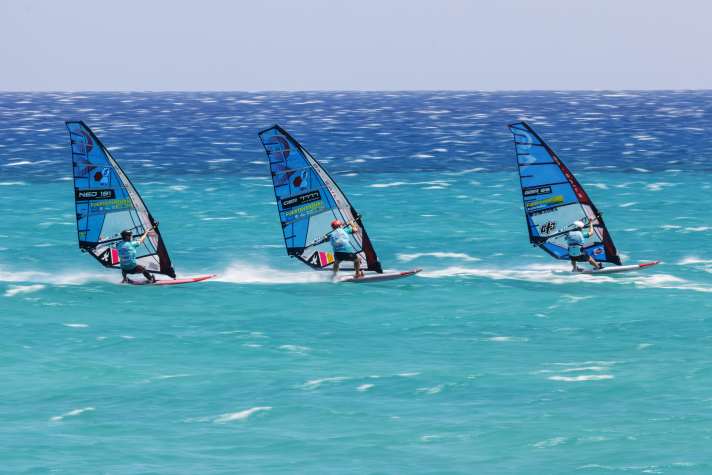
Tips for speed blur photos
Do you have any tips on how to get a good photo with this speed blur effect? Which settings and which lens is best to achieve this effect?
A 100 to 500mm is pretty good for this. If the action is parallel to you, it's much easier. At a minimum of maybe 1/200 or 1/125 of a second, you start to see the blur in the image. I might start pretty conservatively, but as the subject passes by, I might slow down as I shoot and then take a shot down to 1/15 second. Many good photos with speed blur are around 1/40th or 1/60th of a second, which is fine. But the really dynamic ones are at even longer times.
The perfect time of day
Some photographers say they don't shoot between 10 in the morning and 4 in the afternoon. What is the best time for windsurfing photos?
That's a good question. The thing about events is that they usually start at 10am and finish around 4pm. You get excited when they finish with the heats because that's when the light often gets better. That's when you really want to start photographing, but at the same time you've been shooting for six hours and have to edit all the pictures. But yes, I prefer the better light. Obviously it makes for better pictures. As an amateur photographer taking pictures of your friends, you are free. You can choose: against the light, with the light. You can shoot in the morning or in the afternoon.
Do you have any tips on the best time or position to take beautiful sunset pictures?
Yes, as always, the last hour or two of daylight are always a little warmer and make everything seem a little more golden. It's beautiful... If you're shooting on the west coast, you're often shooting against strong backlight in the afternoon, which isn't particularly interesting. But once you get into the last hour, beautiful orange tones or pinks start to show in the sky, or you get beautiful silhouettes because the waves are lit up by the sunlight behind them. That's a good time to wait for.
So you shouldn't start taking photos too early?

We call it the golden hour. Like in Australia. I was there with Scott McKercher and a few others. We didn't get to the beach until seven in the evening because we knew the sun was going to set at 8:30, and we shot for that hour or hour and a half because that was the best time. We knew that's when we would get these really beautiful wave images with glowing spray. The three hours before that it's just bright, burnt out. You can barely see what's going on with the naked eye. So if you can choose, the nicer light is better. But sometimes that also means more commitment, because everyone else might be at dinner at eight o'clock in the evening while you're still on the beach.
Sometimes more commitment is required. Because maybe everyone else is already at dinner while you're still standing on the beach. (John Carter)
I remember these really great shots of yours. Of Sylt with these beautiful colours in the sky, and that must have been around sunset time.
To get good shots in this situation, there's only a small area of the sunset time that provides that good shot, and it's either directly into the sun or around the sun. But if you go too far away from the sun, it loses that effect. So when I'm shooting that late in the day, I'm just waiting for some good action to happen in that little area.
Is there any other advice you would give to someone who wants to take better action photos?
Sometimes, when you've been photographing for a while, you should stop and think: 'Wait a minute, maybe this looks better further away'. Or you need to start thinking: 'What does it look like from over there? Am I in the best place? I often think, 'Let's try something else'. Don't be afraid to move and you'll quickly find out if the other place is worse, but always try or try to imagine what something would look like from a different angle. Because sometimes you might shoot all day at an event and post your gallery online, and then you see that someone else has posted their pictures who was positioned somewhere else, and you think, 'My God, that looks amazing from over there.
I think that's good advice.
One last thing is also to look at a lot of photography. Because you will get ideas and maybe you can copy those ideas and make your own pictures look better. But it's not just windsurfing photography, it's any sport. If you find good portrait photographers, it's nice to just look at their pictures and find out how they did it. And don't go anywhere unprepared. If you're going somewhere stormy, take that rain cover with you. If you're going somewhere where you know it's going to be far out, you need to have that long zoom lens. Just be prepared. Keep your batteries charged. Check your memory cards. Make sure you have your chargers. Check you have an SD card in the camera. Before you walk 500 metres down the beach with a 500mm lens and heavy tripod on your back and then realise that. You have a lot of preparation that is just as important as the actual photography.
John, thank you very much for the interview and get well soon!

